Risk Management Framework and Strategies for David Jones, Australia
VerifiedAdded on 2022/08/09
|15
|2507
|25
Report
AI Summary
This report provides a comprehensive analysis of risk management within David Jones, an Australian upmarket departmental store. It begins with an introduction to David Jones, including its background, structure, mission, and objectives, as well as gaps in its risk principles. The report then assesses both internal and external stakeholders, identifying potential risks related to competition, technological advancements, and financial constraints. It evaluates the internal and external risk environments, highlighting strengths, weaknesses, opportunities, and threats (SWOT). The report explores the integration of risk management, including current gaps in risk management frameworks and the value of formal risk management. Identified risks include lack of market knowledge, technological deficiencies, and diminishing margins, which are assessed using fishbone analysis. Finally, the report presents a risk register and a detailed risk mitigation plan, outlining treatment strategies, resources, and deadlines for addressing identified risks, referencing the ISO 31000 guidelines.
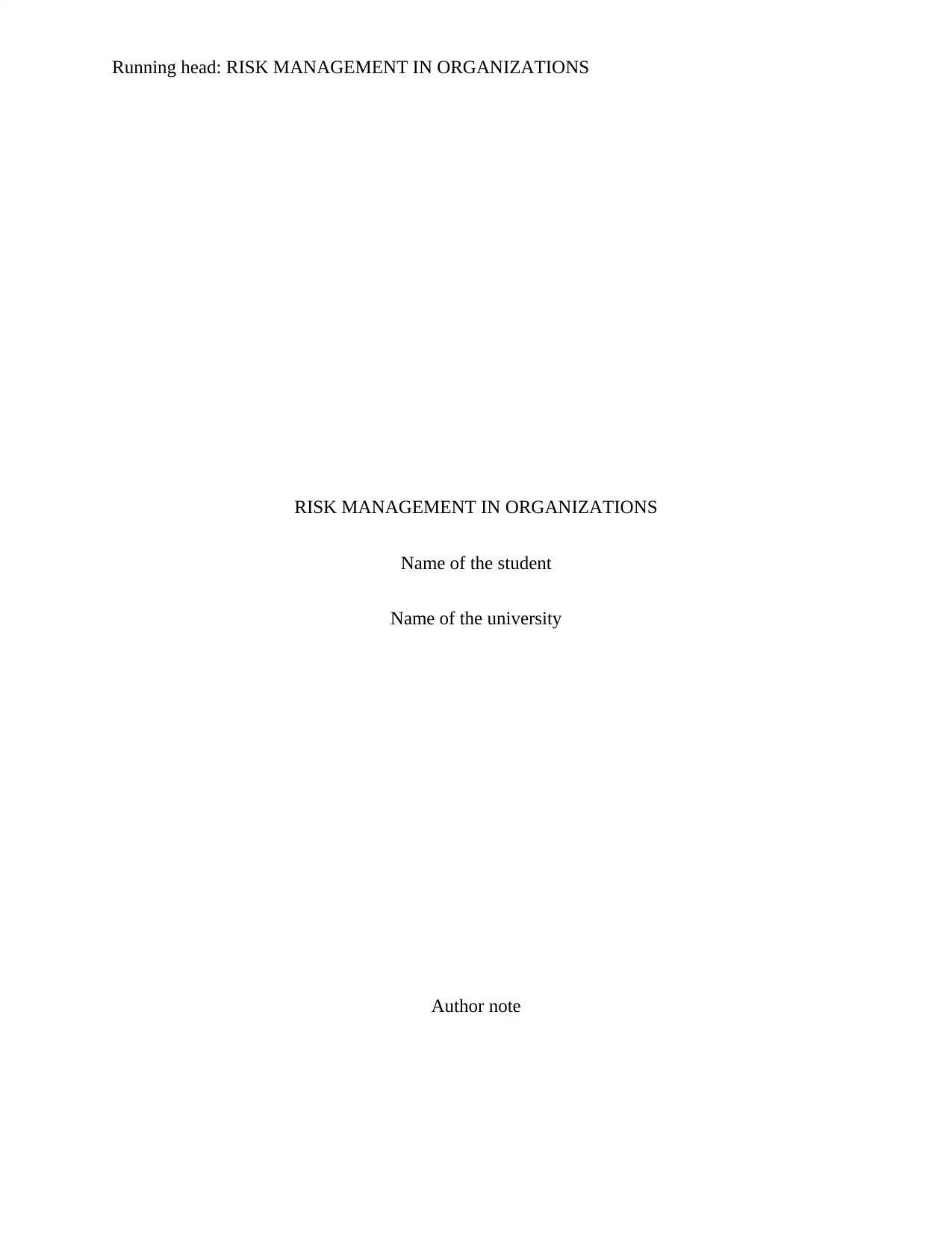
Running head: RISK MANAGEMENT IN ORGANIZATIONS
RISK MANAGEMENT IN ORGANIZATIONS
Name of the student
Name of the university
Author note
RISK MANAGEMENT IN ORGANIZATIONS
Name of the student
Name of the university
Author note
Paraphrase This Document
Need a fresh take? Get an instant paraphrase of this document with our AI Paraphraser
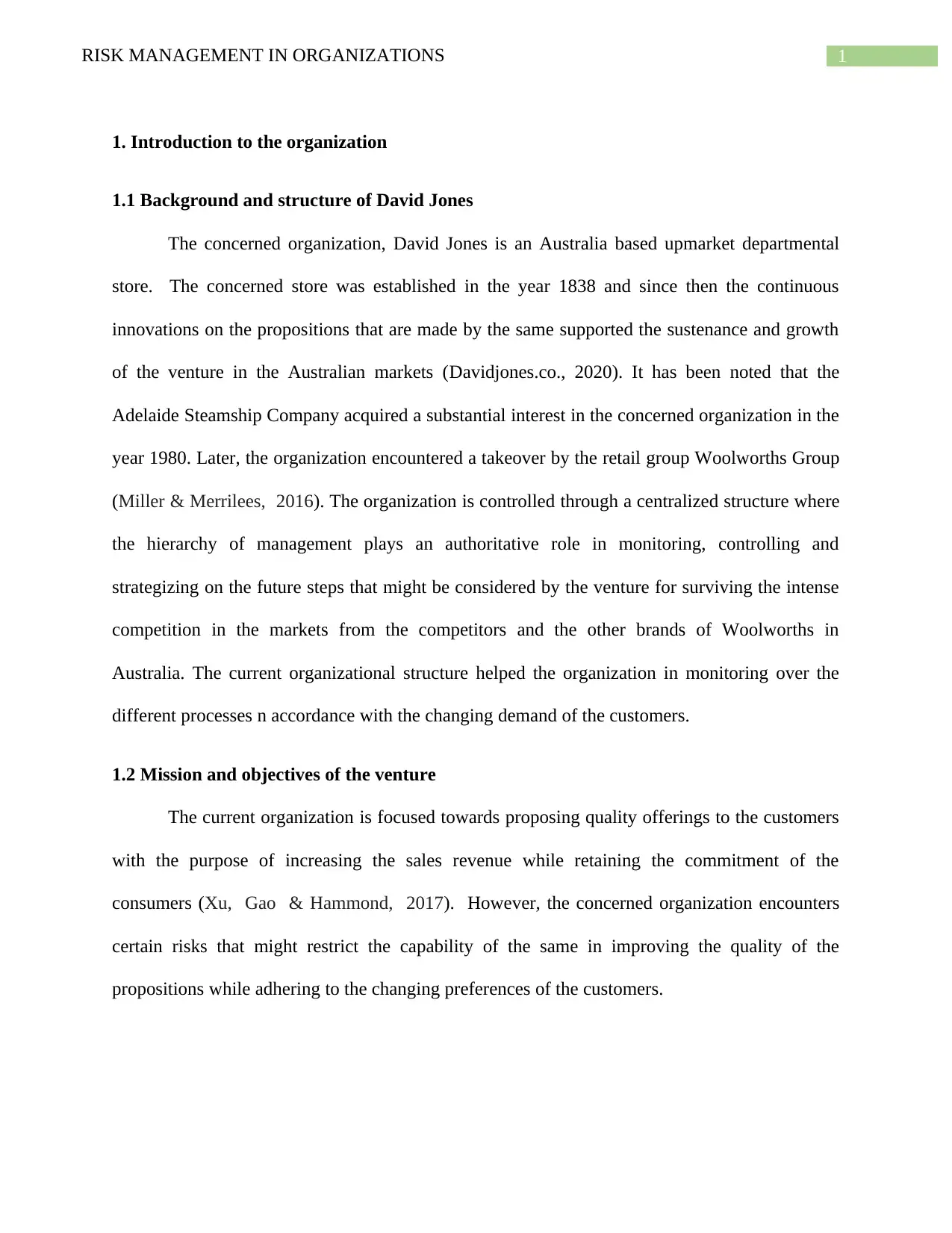
1RISK MANAGEMENT IN ORGANIZATIONS
1. Introduction to the organization
1.1 Background and structure of David Jones
The concerned organization, David Jones is an Australia based upmarket departmental
store. The concerned store was established in the year 1838 and since then the continuous
innovations on the propositions that are made by the same supported the sustenance and growth
of the venture in the Australian markets (Davidjones.co., 2020). It has been noted that the
Adelaide Steamship Company acquired a substantial interest in the concerned organization in the
year 1980. Later, the organization encountered a takeover by the retail group Woolworths Group
(Miller & Merrilees, 2016). The organization is controlled through a centralized structure where
the hierarchy of management plays an authoritative role in monitoring, controlling and
strategizing on the future steps that might be considered by the venture for surviving the intense
competition in the markets from the competitors and the other brands of Woolworths in
Australia. The current organizational structure helped the organization in monitoring over the
different processes n accordance with the changing demand of the customers.
1.2 Mission and objectives of the venture
The current organization is focused towards proposing quality offerings to the customers
with the purpose of increasing the sales revenue while retaining the commitment of the
consumers (Xu, Gao & Hammond, 2017). However, the concerned organization encounters
certain risks that might restrict the capability of the same in improving the quality of the
propositions while adhering to the changing preferences of the customers.
1. Introduction to the organization
1.1 Background and structure of David Jones
The concerned organization, David Jones is an Australia based upmarket departmental
store. The concerned store was established in the year 1838 and since then the continuous
innovations on the propositions that are made by the same supported the sustenance and growth
of the venture in the Australian markets (Davidjones.co., 2020). It has been noted that the
Adelaide Steamship Company acquired a substantial interest in the concerned organization in the
year 1980. Later, the organization encountered a takeover by the retail group Woolworths Group
(Miller & Merrilees, 2016). The organization is controlled through a centralized structure where
the hierarchy of management plays an authoritative role in monitoring, controlling and
strategizing on the future steps that might be considered by the venture for surviving the intense
competition in the markets from the competitors and the other brands of Woolworths in
Australia. The current organizational structure helped the organization in monitoring over the
different processes n accordance with the changing demand of the customers.
1.2 Mission and objectives of the venture
The current organization is focused towards proposing quality offerings to the customers
with the purpose of increasing the sales revenue while retaining the commitment of the
consumers (Xu, Gao & Hammond, 2017). However, the concerned organization encounters
certain risks that might restrict the capability of the same in improving the quality of the
propositions while adhering to the changing preferences of the customers.
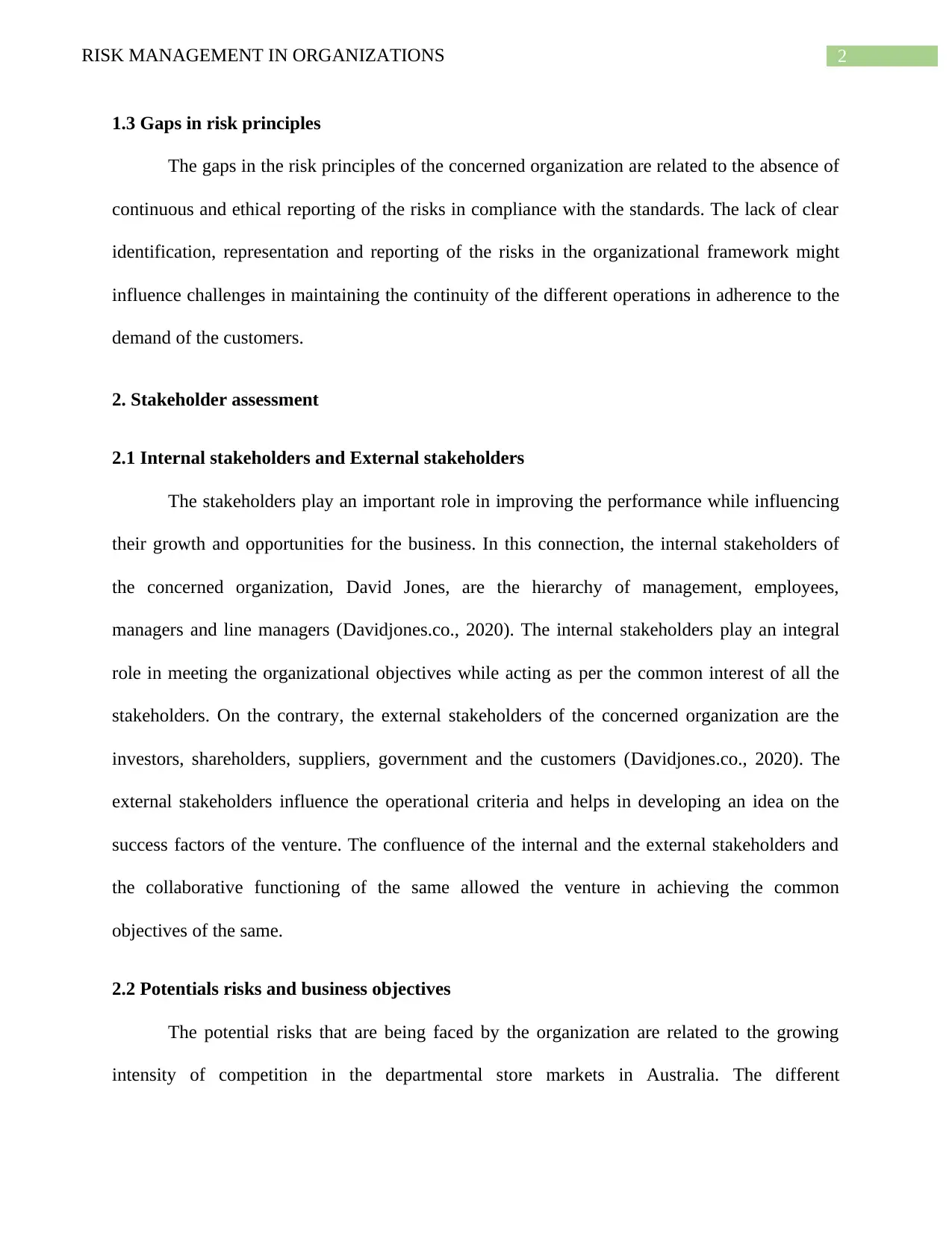
2RISK MANAGEMENT IN ORGANIZATIONS
1.3 Gaps in risk principles
The gaps in the risk principles of the concerned organization are related to the absence of
continuous and ethical reporting of the risks in compliance with the standards. The lack of clear
identification, representation and reporting of the risks in the organizational framework might
influence challenges in maintaining the continuity of the different operations in adherence to the
demand of the customers.
2. Stakeholder assessment
2.1 Internal stakeholders and External stakeholders
The stakeholders play an important role in improving the performance while influencing
their growth and opportunities for the business. In this connection, the internal stakeholders of
the concerned organization, David Jones, are the hierarchy of management, employees,
managers and line managers (Davidjones.co., 2020). The internal stakeholders play an integral
role in meeting the organizational objectives while acting as per the common interest of all the
stakeholders. On the contrary, the external stakeholders of the concerned organization are the
investors, shareholders, suppliers, government and the customers (Davidjones.co., 2020). The
external stakeholders influence the operational criteria and helps in developing an idea on the
success factors of the venture. The confluence of the internal and the external stakeholders and
the collaborative functioning of the same allowed the venture in achieving the common
objectives of the same.
2.2 Potentials risks and business objectives
The potential risks that are being faced by the organization are related to the growing
intensity of competition in the departmental store markets in Australia. The different
1.3 Gaps in risk principles
The gaps in the risk principles of the concerned organization are related to the absence of
continuous and ethical reporting of the risks in compliance with the standards. The lack of clear
identification, representation and reporting of the risks in the organizational framework might
influence challenges in maintaining the continuity of the different operations in adherence to the
demand of the customers.
2. Stakeholder assessment
2.1 Internal stakeholders and External stakeholders
The stakeholders play an important role in improving the performance while influencing
their growth and opportunities for the business. In this connection, the internal stakeholders of
the concerned organization, David Jones, are the hierarchy of management, employees,
managers and line managers (Davidjones.co., 2020). The internal stakeholders play an integral
role in meeting the organizational objectives while acting as per the common interest of all the
stakeholders. On the contrary, the external stakeholders of the concerned organization are the
investors, shareholders, suppliers, government and the customers (Davidjones.co., 2020). The
external stakeholders influence the operational criteria and helps in developing an idea on the
success factors of the venture. The confluence of the internal and the external stakeholders and
the collaborative functioning of the same allowed the venture in achieving the common
objectives of the same.
2.2 Potentials risks and business objectives
The potential risks that are being faced by the organization are related to the growing
intensity of competition in the departmental store markets in Australia. The different
⊘ This is a preview!⊘
Do you want full access?
Subscribe today to unlock all pages.

Trusted by 1+ million students worldwide
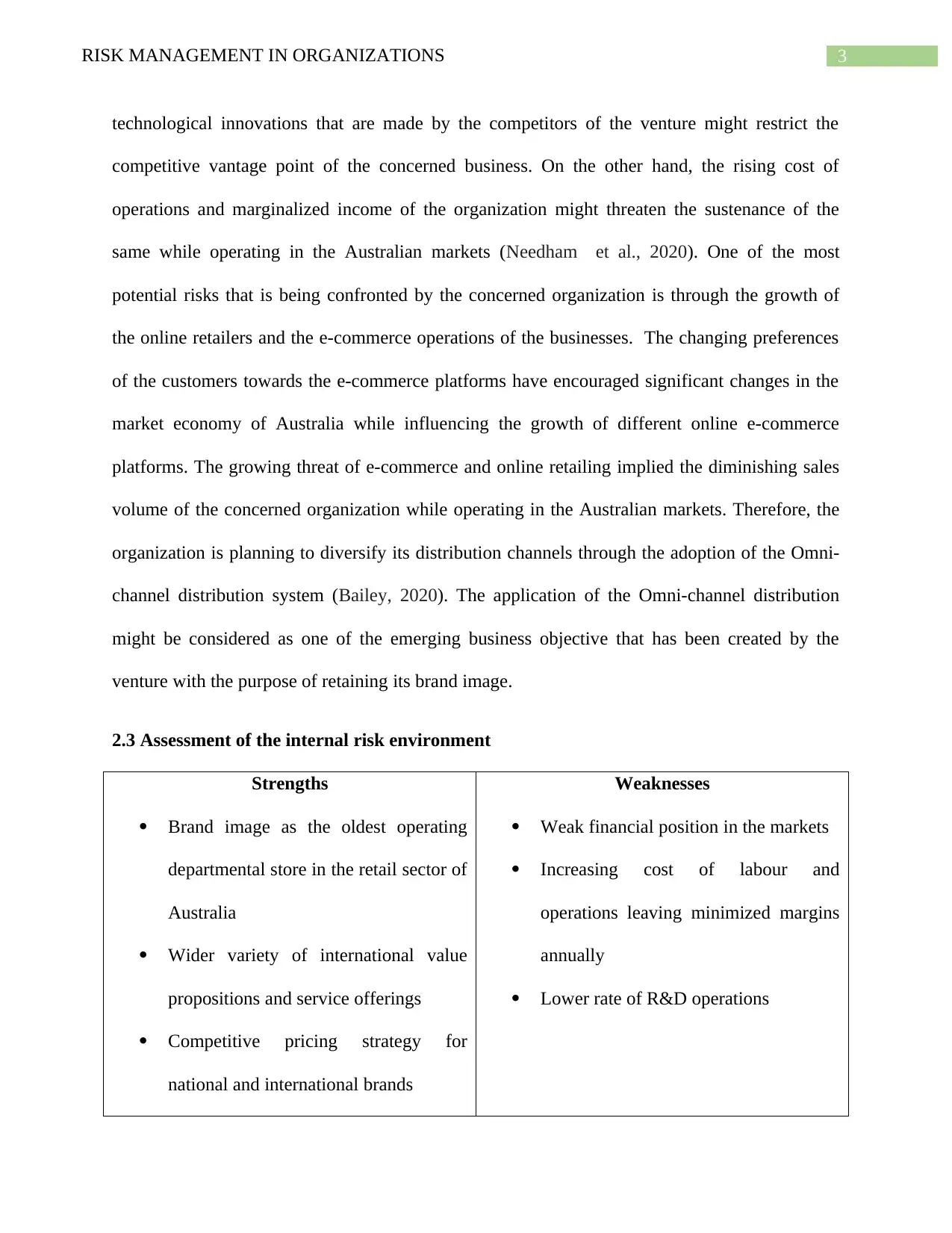
3RISK MANAGEMENT IN ORGANIZATIONS
technological innovations that are made by the competitors of the venture might restrict the
competitive vantage point of the concerned business. On the other hand, the rising cost of
operations and marginalized income of the organization might threaten the sustenance of the
same while operating in the Australian markets (Needham et al., 2020). One of the most
potential risks that is being confronted by the concerned organization is through the growth of
the online retailers and the e-commerce operations of the businesses. The changing preferences
of the customers towards the e-commerce platforms have encouraged significant changes in the
market economy of Australia while influencing the growth of different online e-commerce
platforms. The growing threat of e-commerce and online retailing implied the diminishing sales
volume of the concerned organization while operating in the Australian markets. Therefore, the
organization is planning to diversify its distribution channels through the adoption of the Omni-
channel distribution system (Bailey, 2020). The application of the Omni-channel distribution
might be considered as one of the emerging business objective that has been created by the
venture with the purpose of retaining its brand image.
2.3 Assessment of the internal risk environment
Strengths
Brand image as the oldest operating
departmental store in the retail sector of
Australia
Wider variety of international value
propositions and service offerings
Competitive pricing strategy for
national and international brands
Weaknesses
Weak financial position in the markets
Increasing cost of labour and
operations leaving minimized margins
annually
Lower rate of R&D operations
technological innovations that are made by the competitors of the venture might restrict the
competitive vantage point of the concerned business. On the other hand, the rising cost of
operations and marginalized income of the organization might threaten the sustenance of the
same while operating in the Australian markets (Needham et al., 2020). One of the most
potential risks that is being confronted by the concerned organization is through the growth of
the online retailers and the e-commerce operations of the businesses. The changing preferences
of the customers towards the e-commerce platforms have encouraged significant changes in the
market economy of Australia while influencing the growth of different online e-commerce
platforms. The growing threat of e-commerce and online retailing implied the diminishing sales
volume of the concerned organization while operating in the Australian markets. Therefore, the
organization is planning to diversify its distribution channels through the adoption of the Omni-
channel distribution system (Bailey, 2020). The application of the Omni-channel distribution
might be considered as one of the emerging business objective that has been created by the
venture with the purpose of retaining its brand image.
2.3 Assessment of the internal risk environment
Strengths
Brand image as the oldest operating
departmental store in the retail sector of
Australia
Wider variety of international value
propositions and service offerings
Competitive pricing strategy for
national and international brands
Weaknesses
Weak financial position in the markets
Increasing cost of labour and
operations leaving minimized margins
annually
Lower rate of R&D operations
Paraphrase This Document
Need a fresh take? Get an instant paraphrase of this document with our AI Paraphraser
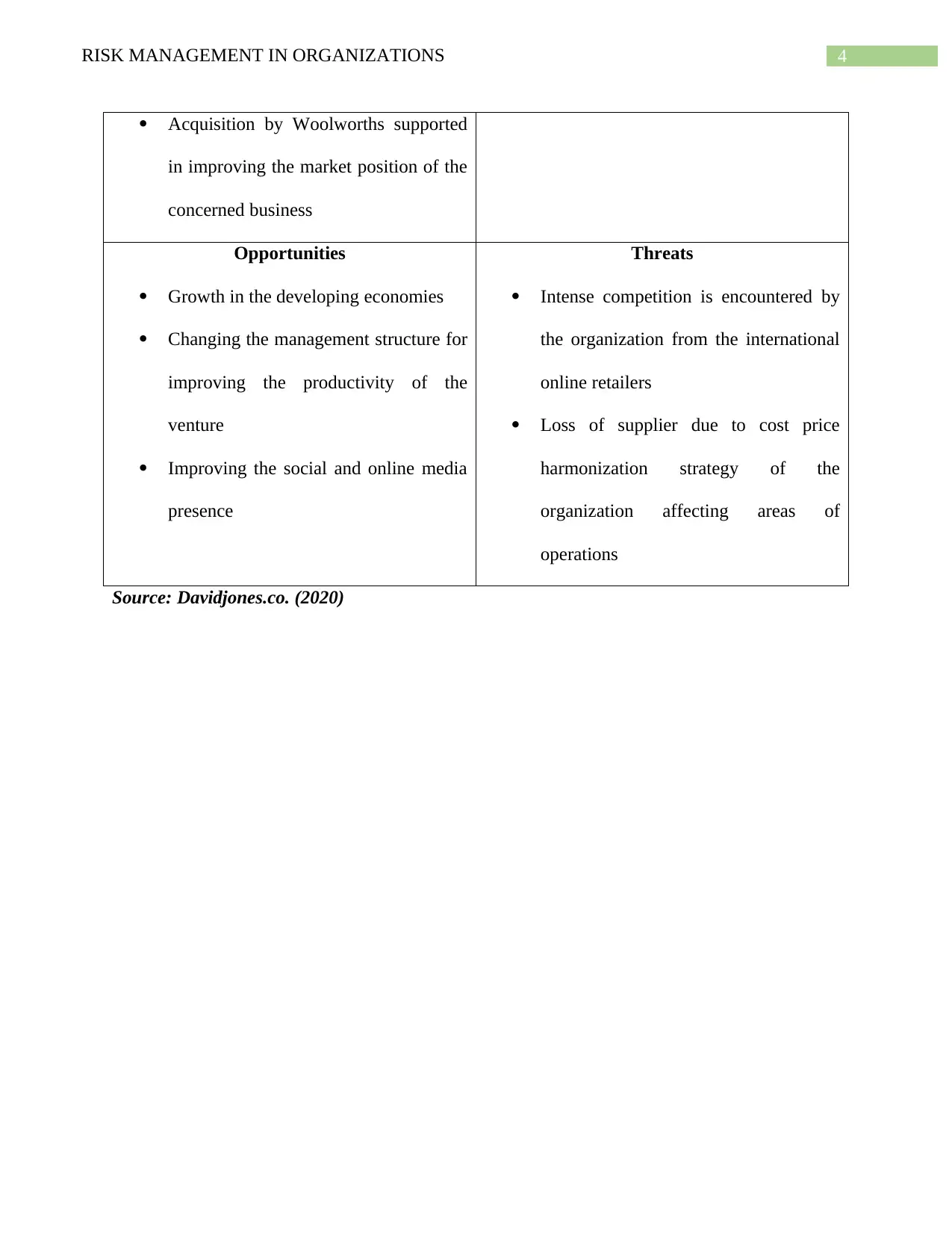
4RISK MANAGEMENT IN ORGANIZATIONS
Acquisition by Woolworths supported
in improving the market position of the
concerned business
Opportunities
Growth in the developing economies
Changing the management structure for
improving the productivity of the
venture
Improving the social and online media
presence
Threats
Intense competition is encountered by
the organization from the international
online retailers
Loss of supplier due to cost price
harmonization strategy of the
organization affecting areas of
operations
Source: Davidjones.co. (2020)
Acquisition by Woolworths supported
in improving the market position of the
concerned business
Opportunities
Growth in the developing economies
Changing the management structure for
improving the productivity of the
venture
Improving the social and online media
presence
Threats
Intense competition is encountered by
the organization from the international
online retailers
Loss of supplier due to cost price
harmonization strategy of the
organization affecting areas of
operations
Source: Davidjones.co. (2020)
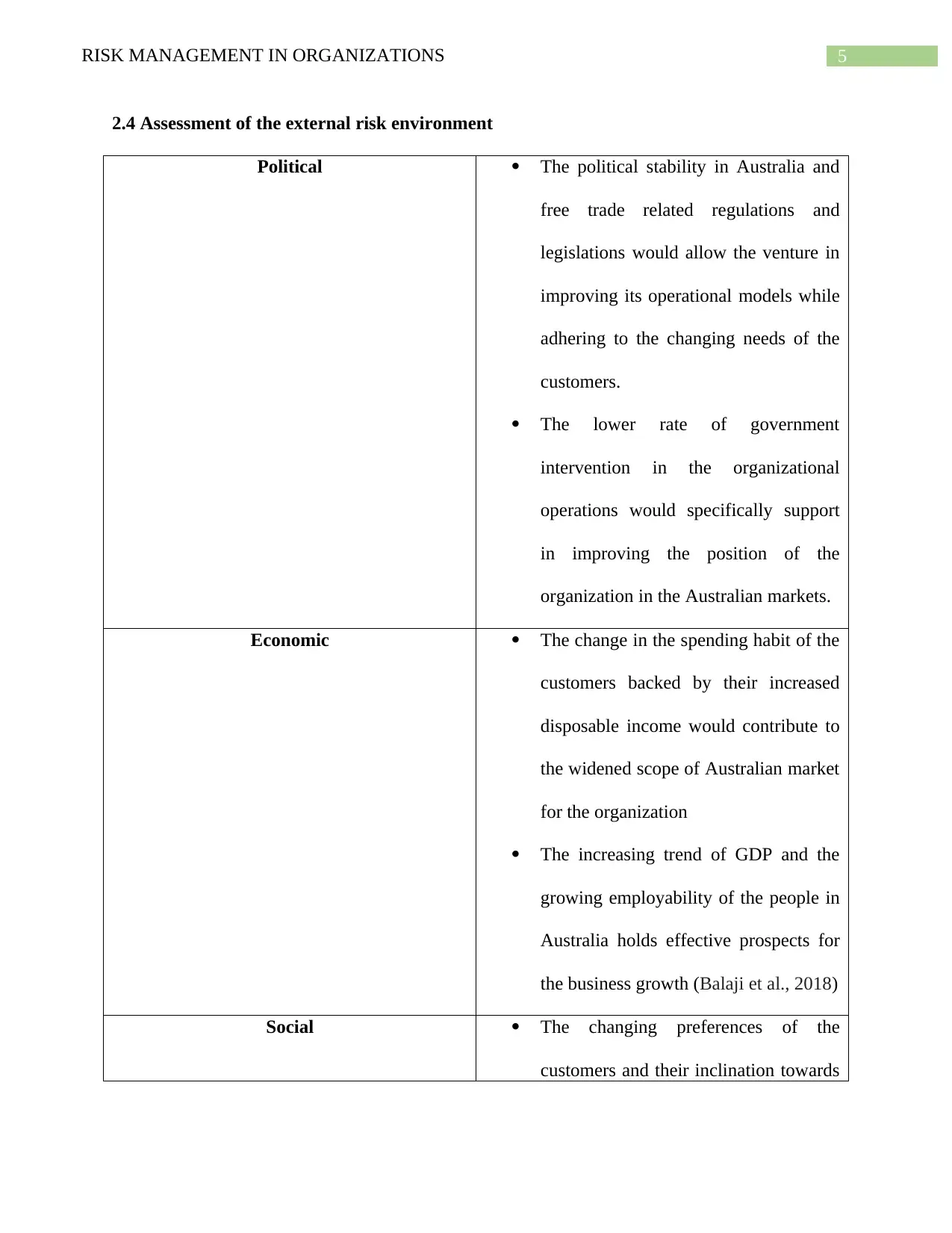
5RISK MANAGEMENT IN ORGANIZATIONS
2.4 Assessment of the external risk environment
Political The political stability in Australia and
free trade related regulations and
legislations would allow the venture in
improving its operational models while
adhering to the changing needs of the
customers.
The lower rate of government
intervention in the organizational
operations would specifically support
in improving the position of the
organization in the Australian markets.
Economic The change in the spending habit of the
customers backed by their increased
disposable income would contribute to
the widened scope of Australian market
for the organization
The increasing trend of GDP and the
growing employability of the people in
Australia holds effective prospects for
the business growth (Balaji et al., 2018)
Social The changing preferences of the
customers and their inclination towards
2.4 Assessment of the external risk environment
Political The political stability in Australia and
free trade related regulations and
legislations would allow the venture in
improving its operational models while
adhering to the changing needs of the
customers.
The lower rate of government
intervention in the organizational
operations would specifically support
in improving the position of the
organization in the Australian markets.
Economic The change in the spending habit of the
customers backed by their increased
disposable income would contribute to
the widened scope of Australian market
for the organization
The increasing trend of GDP and the
growing employability of the people in
Australia holds effective prospects for
the business growth (Balaji et al., 2018)
Social The changing preferences of the
customers and their inclination towards
⊘ This is a preview!⊘
Do you want full access?
Subscribe today to unlock all pages.

Trusted by 1+ million students worldwide
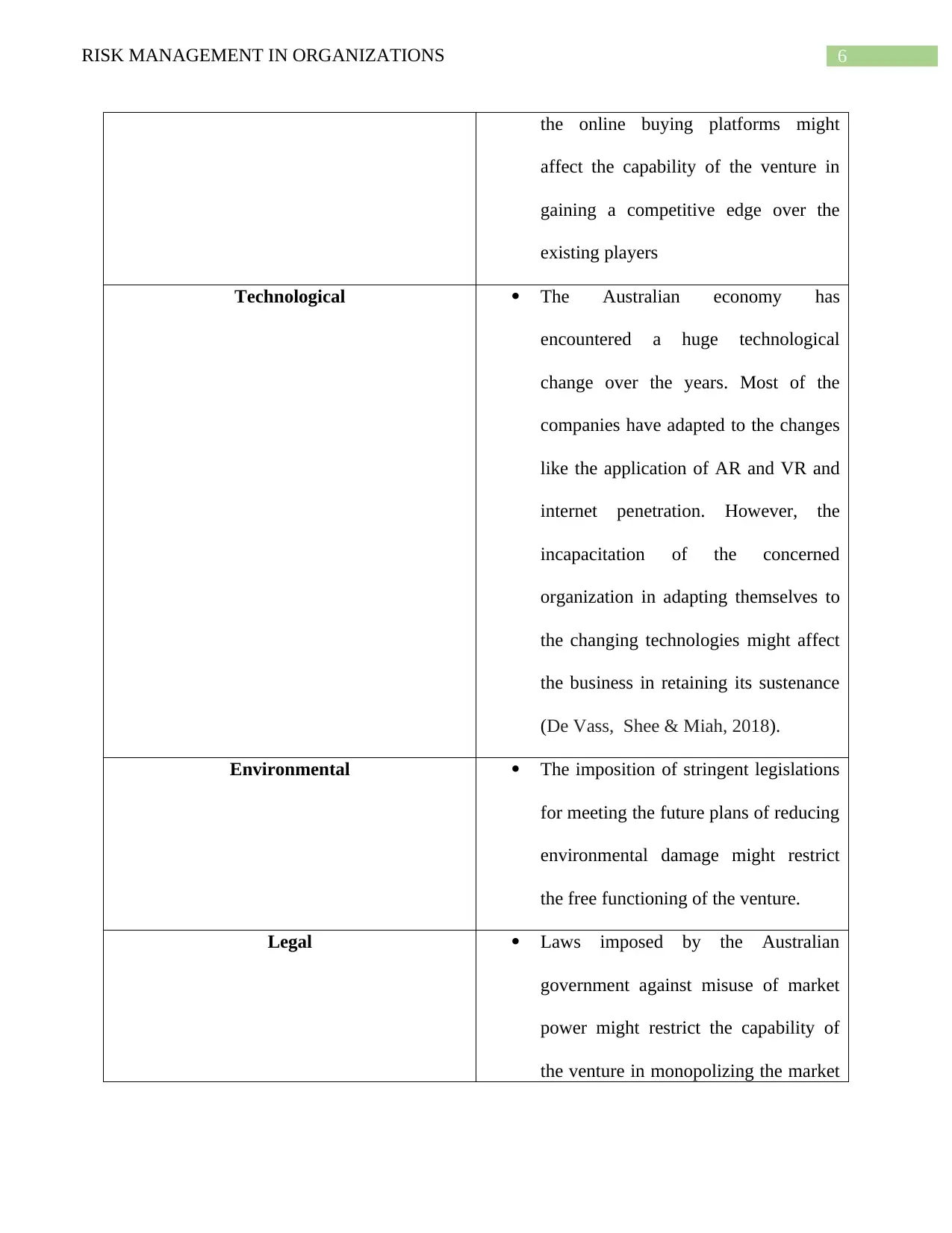
6RISK MANAGEMENT IN ORGANIZATIONS
the online buying platforms might
affect the capability of the venture in
gaining a competitive edge over the
existing players
Technological The Australian economy has
encountered a huge technological
change over the years. Most of the
companies have adapted to the changes
like the application of AR and VR and
internet penetration. However, the
incapacitation of the concerned
organization in adapting themselves to
the changing technologies might affect
the business in retaining its sustenance
(De Vass, Shee & Miah, 2018).
Environmental The imposition of stringent legislations
for meeting the future plans of reducing
environmental damage might restrict
the free functioning of the venture.
Legal Laws imposed by the Australian
government against misuse of market
power might restrict the capability of
the venture in monopolizing the market
the online buying platforms might
affect the capability of the venture in
gaining a competitive edge over the
existing players
Technological The Australian economy has
encountered a huge technological
change over the years. Most of the
companies have adapted to the changes
like the application of AR and VR and
internet penetration. However, the
incapacitation of the concerned
organization in adapting themselves to
the changing technologies might affect
the business in retaining its sustenance
(De Vass, Shee & Miah, 2018).
Environmental The imposition of stringent legislations
for meeting the future plans of reducing
environmental damage might restrict
the free functioning of the venture.
Legal Laws imposed by the Australian
government against misuse of market
power might restrict the capability of
the venture in monopolizing the market
Paraphrase This Document
Need a fresh take? Get an instant paraphrase of this document with our AI Paraphraser
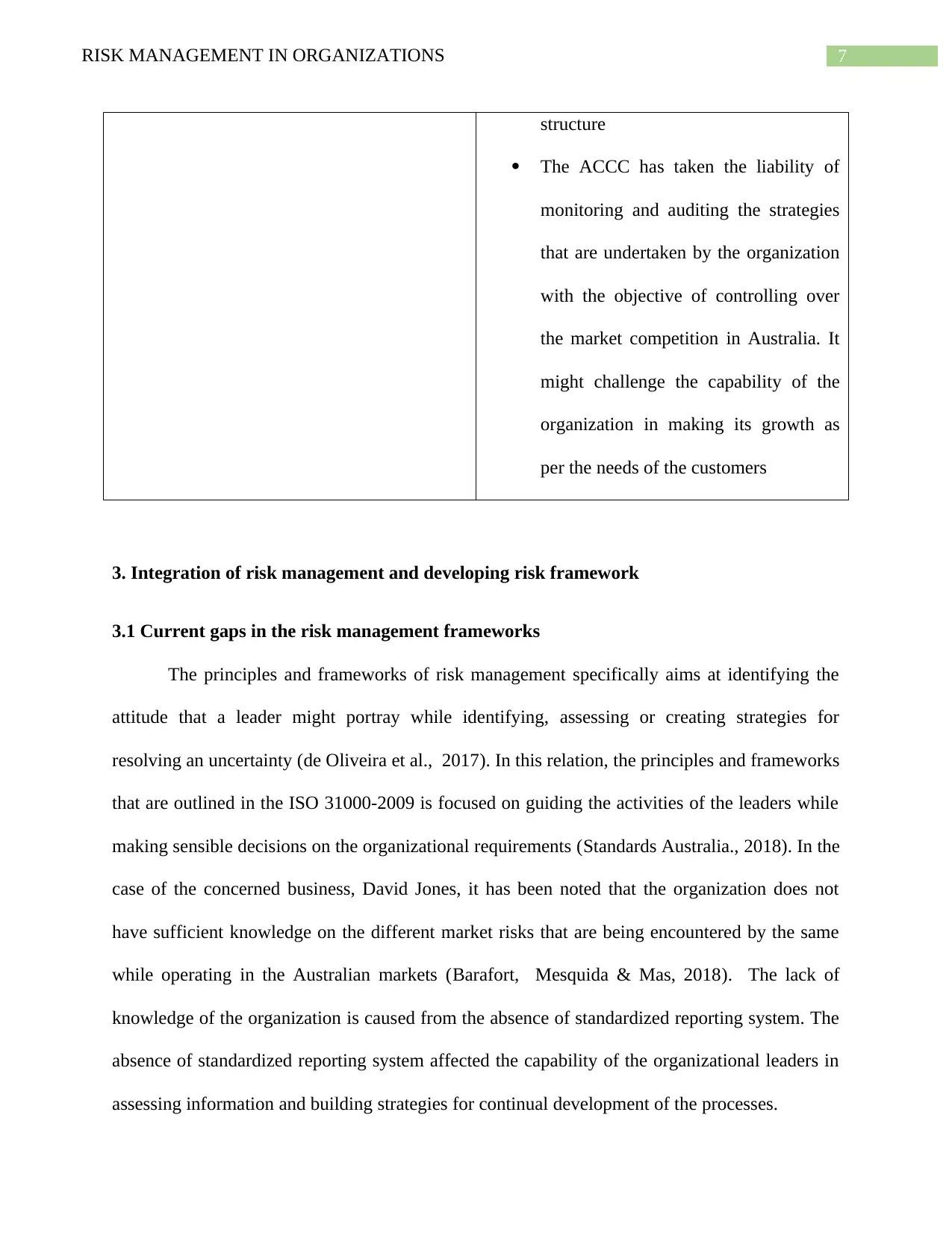
7RISK MANAGEMENT IN ORGANIZATIONS
structure
The ACCC has taken the liability of
monitoring and auditing the strategies
that are undertaken by the organization
with the objective of controlling over
the market competition in Australia. It
might challenge the capability of the
organization in making its growth as
per the needs of the customers
3. Integration of risk management and developing risk framework
3.1 Current gaps in the risk management frameworks
The principles and frameworks of risk management specifically aims at identifying the
attitude that a leader might portray while identifying, assessing or creating strategies for
resolving an uncertainty (de Oliveira et al., 2017). In this relation, the principles and frameworks
that are outlined in the ISO 31000-2009 is focused on guiding the activities of the leaders while
making sensible decisions on the organizational requirements (Standards Australia., 2018). In the
case of the concerned business, David Jones, it has been noted that the organization does not
have sufficient knowledge on the different market risks that are being encountered by the same
while operating in the Australian markets (Barafort, Mesquida & Mas, 2018). The lack of
knowledge of the organization is caused from the absence of standardized reporting system. The
absence of standardized reporting system affected the capability of the organizational leaders in
assessing information and building strategies for continual development of the processes.
structure
The ACCC has taken the liability of
monitoring and auditing the strategies
that are undertaken by the organization
with the objective of controlling over
the market competition in Australia. It
might challenge the capability of the
organization in making its growth as
per the needs of the customers
3. Integration of risk management and developing risk framework
3.1 Current gaps in the risk management frameworks
The principles and frameworks of risk management specifically aims at identifying the
attitude that a leader might portray while identifying, assessing or creating strategies for
resolving an uncertainty (de Oliveira et al., 2017). In this relation, the principles and frameworks
that are outlined in the ISO 31000-2009 is focused on guiding the activities of the leaders while
making sensible decisions on the organizational requirements (Standards Australia., 2018). In the
case of the concerned business, David Jones, it has been noted that the organization does not
have sufficient knowledge on the different market risks that are being encountered by the same
while operating in the Australian markets (Barafort, Mesquida & Mas, 2018). The lack of
knowledge of the organization is caused from the absence of standardized reporting system. The
absence of standardized reporting system affected the capability of the organizational leaders in
assessing information and building strategies for continual development of the processes.
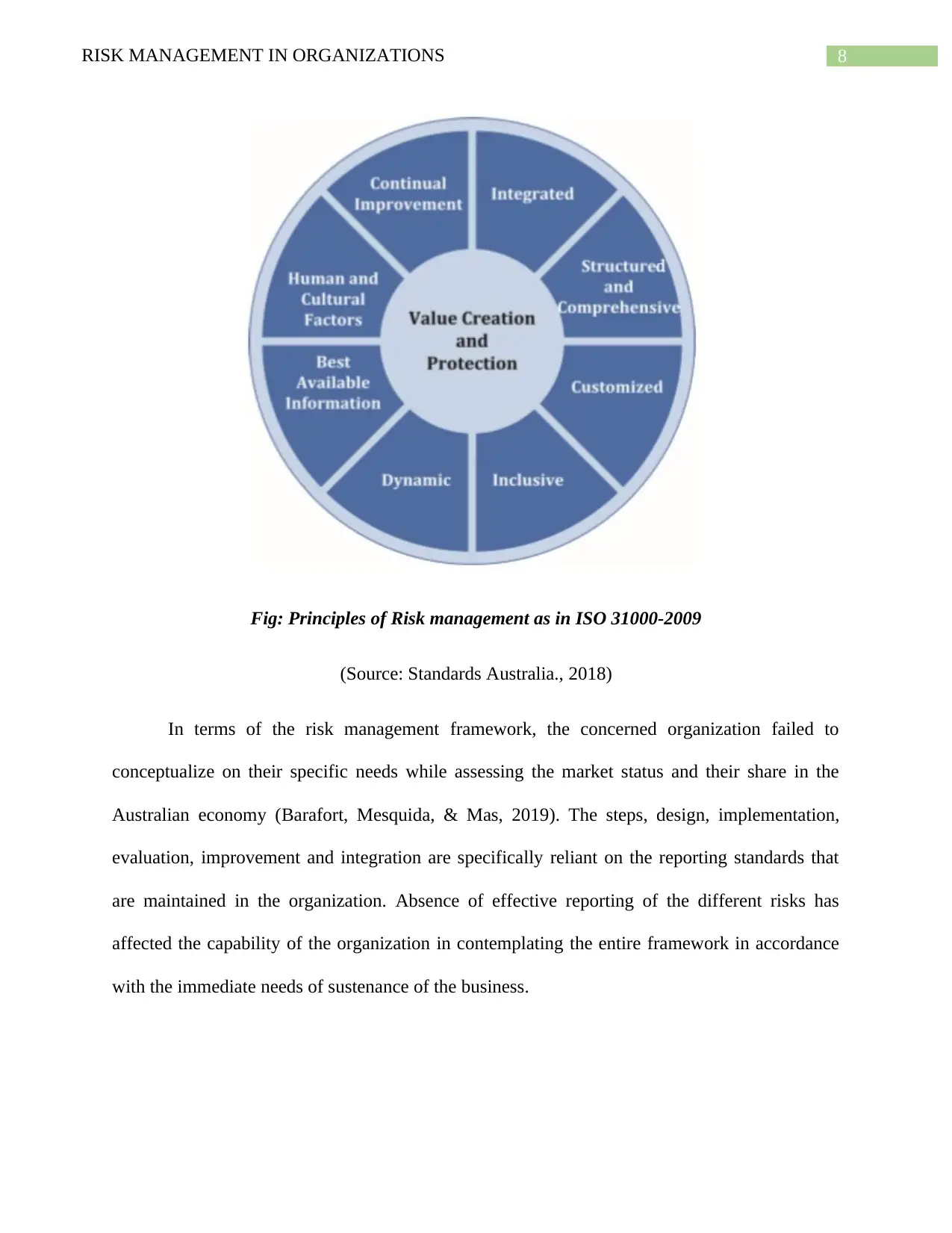
8RISK MANAGEMENT IN ORGANIZATIONS
Fig: Principles of Risk management as in ISO 31000-2009
(Source: Standards Australia., 2018)
In terms of the risk management framework, the concerned organization failed to
conceptualize on their specific needs while assessing the market status and their share in the
Australian economy (Barafort, Mesquida, & Mas, 2019). The steps, design, implementation,
evaluation, improvement and integration are specifically reliant on the reporting standards that
are maintained in the organization. Absence of effective reporting of the different risks has
affected the capability of the organization in contemplating the entire framework in accordance
with the immediate needs of sustenance of the business.
Fig: Principles of Risk management as in ISO 31000-2009
(Source: Standards Australia., 2018)
In terms of the risk management framework, the concerned organization failed to
conceptualize on their specific needs while assessing the market status and their share in the
Australian economy (Barafort, Mesquida, & Mas, 2019). The steps, design, implementation,
evaluation, improvement and integration are specifically reliant on the reporting standards that
are maintained in the organization. Absence of effective reporting of the different risks has
affected the capability of the organization in contemplating the entire framework in accordance
with the immediate needs of sustenance of the business.
⊘ This is a preview!⊘
Do you want full access?
Subscribe today to unlock all pages.

Trusted by 1+ million students worldwide
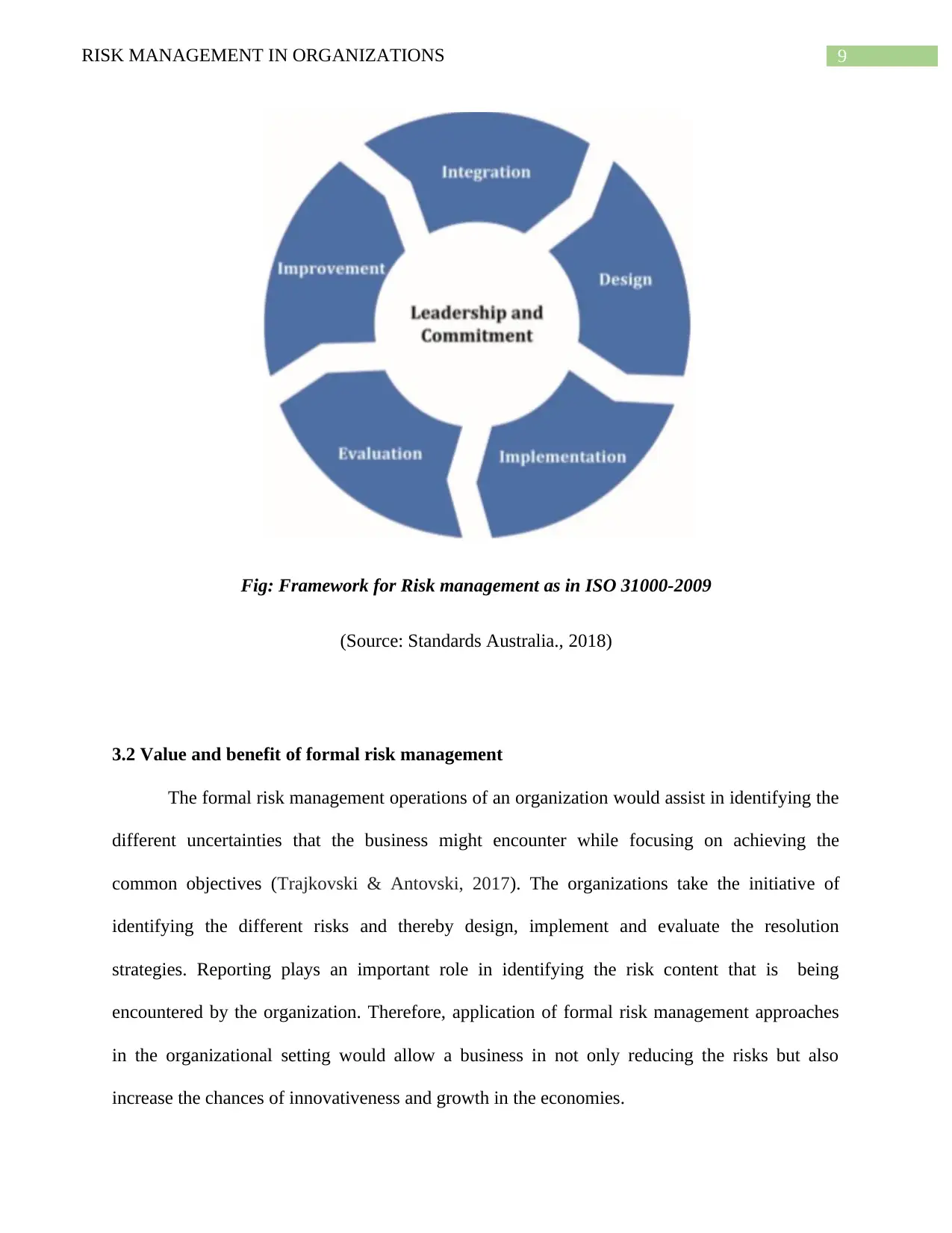
9RISK MANAGEMENT IN ORGANIZATIONS
Fig: Framework for Risk management as in ISO 31000-2009
(Source: Standards Australia., 2018)
3.2 Value and benefit of formal risk management
The formal risk management operations of an organization would assist in identifying the
different uncertainties that the business might encounter while focusing on achieving the
common objectives (Trajkovski & Antovski, 2017). The organizations take the initiative of
identifying the different risks and thereby design, implement and evaluate the resolution
strategies. Reporting plays an important role in identifying the risk content that is being
encountered by the organization. Therefore, application of formal risk management approaches
in the organizational setting would allow a business in not only reducing the risks but also
increase the chances of innovativeness and growth in the economies.
Fig: Framework for Risk management as in ISO 31000-2009
(Source: Standards Australia., 2018)
3.2 Value and benefit of formal risk management
The formal risk management operations of an organization would assist in identifying the
different uncertainties that the business might encounter while focusing on achieving the
common objectives (Trajkovski & Antovski, 2017). The organizations take the initiative of
identifying the different risks and thereby design, implement and evaluate the resolution
strategies. Reporting plays an important role in identifying the risk content that is being
encountered by the organization. Therefore, application of formal risk management approaches
in the organizational setting would allow a business in not only reducing the risks but also
increase the chances of innovativeness and growth in the economies.
Paraphrase This Document
Need a fresh take? Get an instant paraphrase of this document with our AI Paraphraser
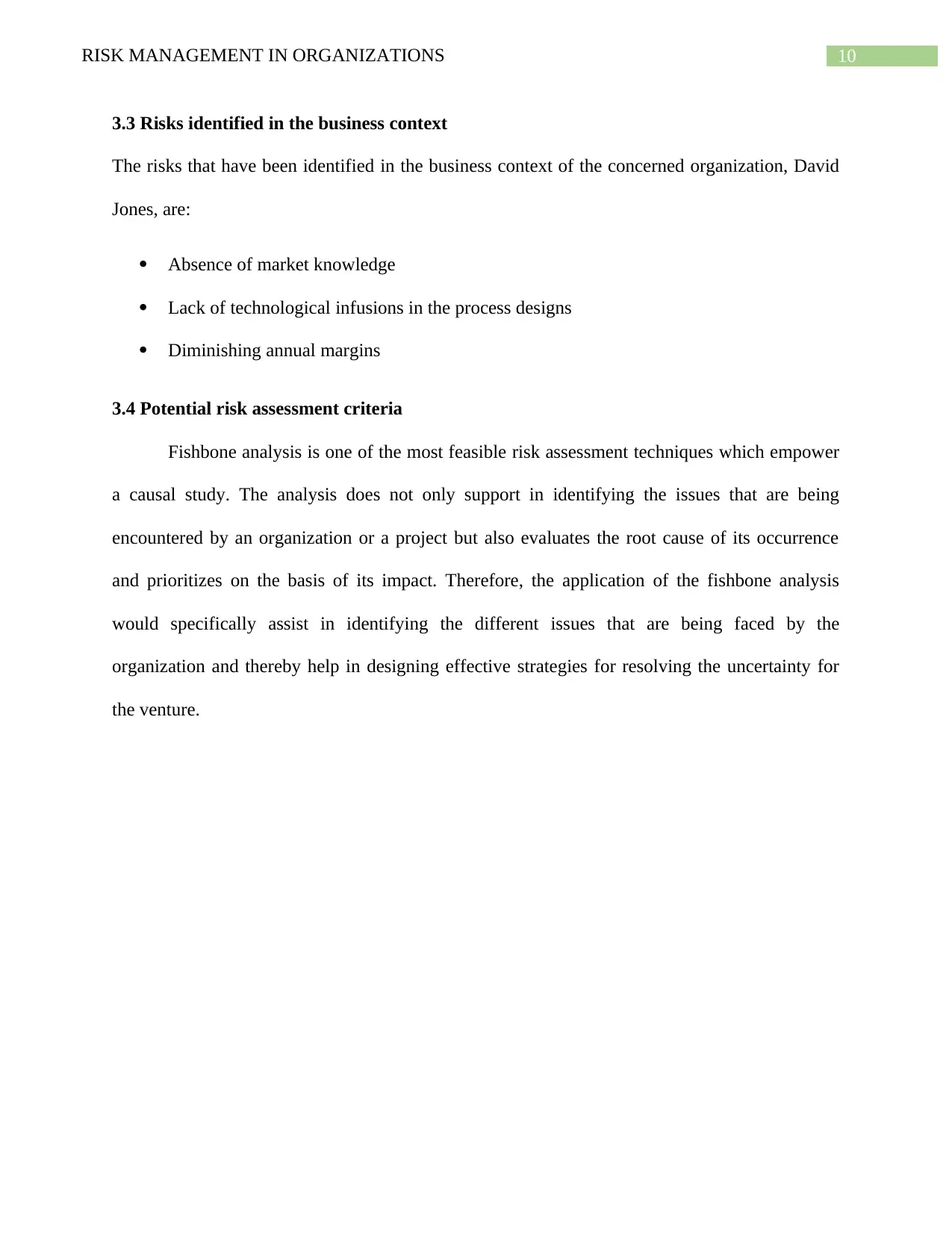
10RISK MANAGEMENT IN ORGANIZATIONS
3.3 Risks identified in the business context
The risks that have been identified in the business context of the concerned organization, David
Jones, are:
Absence of market knowledge
Lack of technological infusions in the process designs
Diminishing annual margins
3.4 Potential risk assessment criteria
Fishbone analysis is one of the most feasible risk assessment techniques which empower
a causal study. The analysis does not only support in identifying the issues that are being
encountered by an organization or a project but also evaluates the root cause of its occurrence
and prioritizes on the basis of its impact. Therefore, the application of the fishbone analysis
would specifically assist in identifying the different issues that are being faced by the
organization and thereby help in designing effective strategies for resolving the uncertainty for
the venture.
3.3 Risks identified in the business context
The risks that have been identified in the business context of the concerned organization, David
Jones, are:
Absence of market knowledge
Lack of technological infusions in the process designs
Diminishing annual margins
3.4 Potential risk assessment criteria
Fishbone analysis is one of the most feasible risk assessment techniques which empower
a causal study. The analysis does not only support in identifying the issues that are being
encountered by an organization or a project but also evaluates the root cause of its occurrence
and prioritizes on the basis of its impact. Therefore, the application of the fishbone analysis
would specifically assist in identifying the different issues that are being faced by the
organization and thereby help in designing effective strategies for resolving the uncertainty for
the venture.
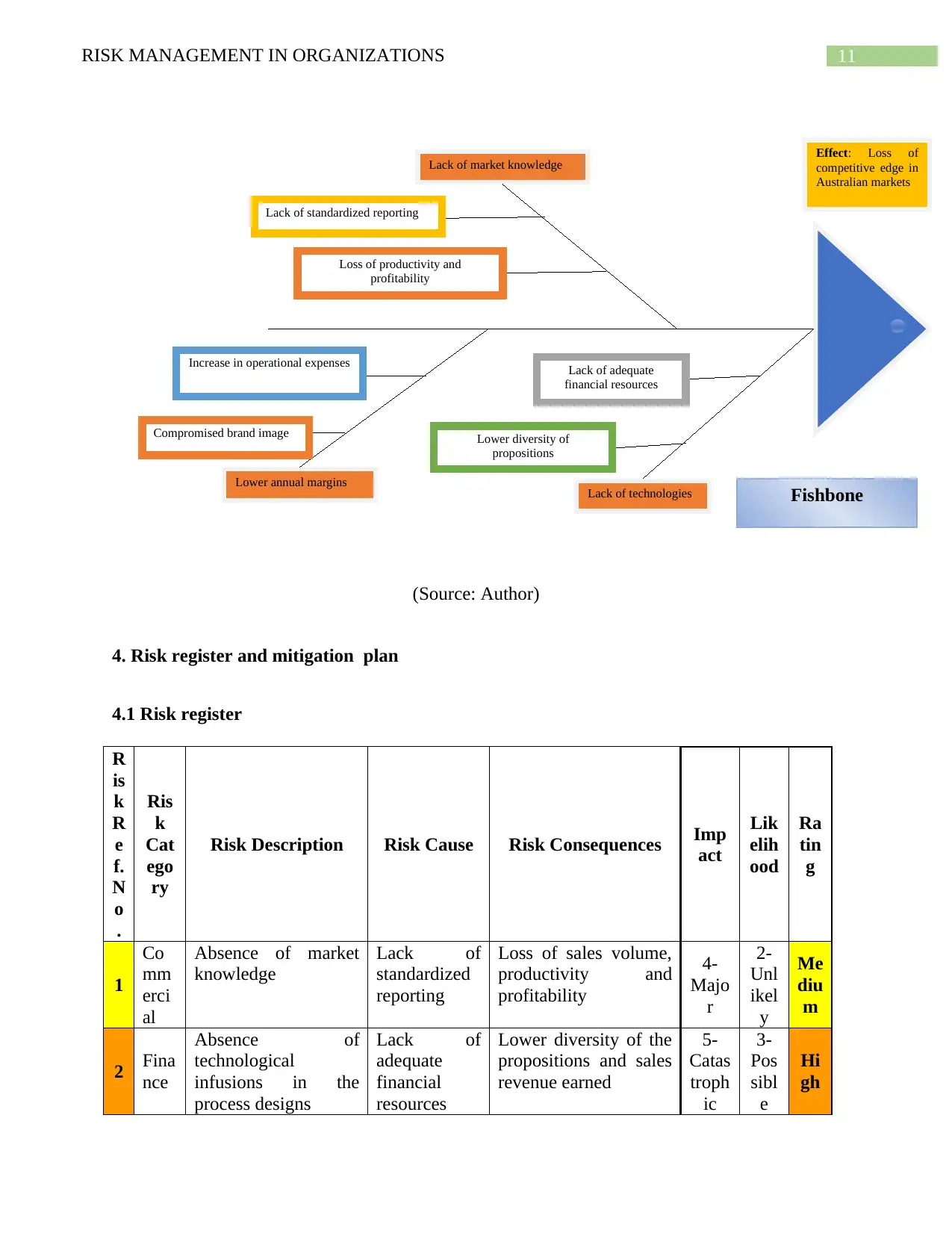
11RISK MANAGEMENT IN ORGANIZATIONS
Lack of market knowledge
Lower annual margins Lack of technologies
Lack of standardized reporting
Loss of productivity and
profitability
Lack of adequate
financial resources
Lower diversity of
propositions
Increase in operational expenses
Compromised brand image
Effect: Loss of
competitive edge in
Australian markets
Fishbone
(Source: Author)
4. Risk register and mitigation plan
4.1 Risk register
R
is
k
R
e
f.
N
o
.
Ris
k
Cat
ego
ry
Risk Description Risk Cause Risk Consequences Imp
act
Lik
elih
ood
Ra
tin
g
1
Co
mm
erci
al
Absence of market
knowledge
Lack of
standardized
reporting
Loss of sales volume,
productivity and
profitability
4-
Majo
r
2-
Unl
ikel
y
Me
diu
m
2 Fina
nce
Absence of
technological
infusions in the
process designs
Lack of
adequate
financial
resources
Lower diversity of the
propositions and sales
revenue earned
5-
Catas
troph
ic
3-
Pos
sibl
e
Hi
gh
Lack of market knowledge
Lower annual margins Lack of technologies
Lack of standardized reporting
Loss of productivity and
profitability
Lack of adequate
financial resources
Lower diversity of
propositions
Increase in operational expenses
Compromised brand image
Effect: Loss of
competitive edge in
Australian markets
Fishbone
(Source: Author)
4. Risk register and mitigation plan
4.1 Risk register
R
is
k
R
e
f.
N
o
.
Ris
k
Cat
ego
ry
Risk Description Risk Cause Risk Consequences Imp
act
Lik
elih
ood
Ra
tin
g
1
Co
mm
erci
al
Absence of market
knowledge
Lack of
standardized
reporting
Loss of sales volume,
productivity and
profitability
4-
Majo
r
2-
Unl
ikel
y
Me
diu
m
2 Fina
nce
Absence of
technological
infusions in the
process designs
Lack of
adequate
financial
resources
Lower diversity of the
propositions and sales
revenue earned
5-
Catas
troph
ic
3-
Pos
sibl
e
Hi
gh
⊘ This is a preview!⊘
Do you want full access?
Subscribe today to unlock all pages.

Trusted by 1+ million students worldwide
1 out of 15
Related Documents
Your All-in-One AI-Powered Toolkit for Academic Success.
+13062052269
info@desklib.com
Available 24*7 on WhatsApp / Email
![[object Object]](/_next/static/media/star-bottom.7253800d.svg)
Unlock your academic potential
Copyright © 2020–2025 A2Z Services. All Rights Reserved. Developed and managed by ZUCOL.





